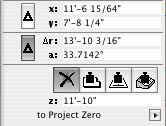There's lots of good reasons to invest the time needed to work the model out. It helps you understand the design, find massing problems, catch tricky details, and get lots of drawings started at once.
Lately we've noticed an advantage that is distinct from these, but related. With a well-developed model, we are less vulnerable to construction errors arising from incomplete annotations.
When we leave off a knee wall height dimension, and they call and ask for it, we can go to the model and measure it. If there's a building section showing the knee wall, and the section is a model view, we can scale the wall and be confident that the relationship between the wall and the roof is correct. Now, don't tell the builder this; the prohibition on scaling to determine dimensions remains. But we're allowed to "scale" the drawings if we know the model is worked out.
Builders are invariably amazed that the ridge elevation ends up within an inch of where we said it would be, on a crazy roof with a bunch of different slopes. We would be amazed if it didn't.
Even if there are annotations missing, there is reliable data in the model. Of course, we should strive to make the annotations as perfect as possible as well. But it is better to have incomplete annotation of reliable geometry, than finished annotation of a model that doesn't actually work.
